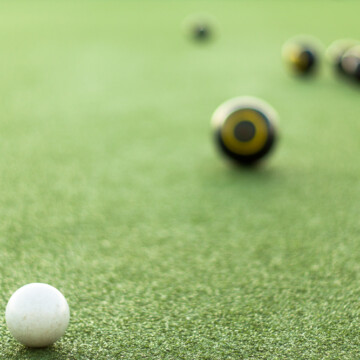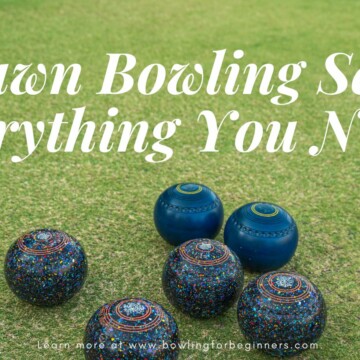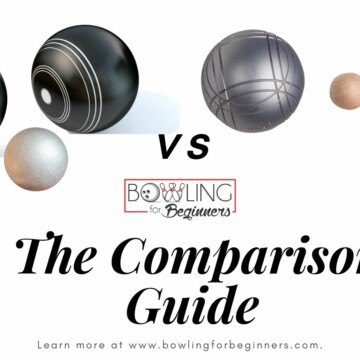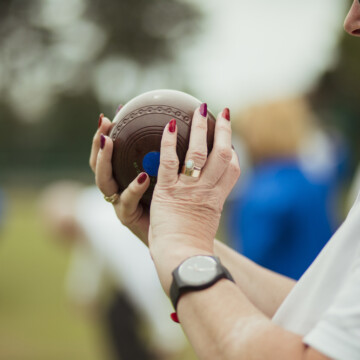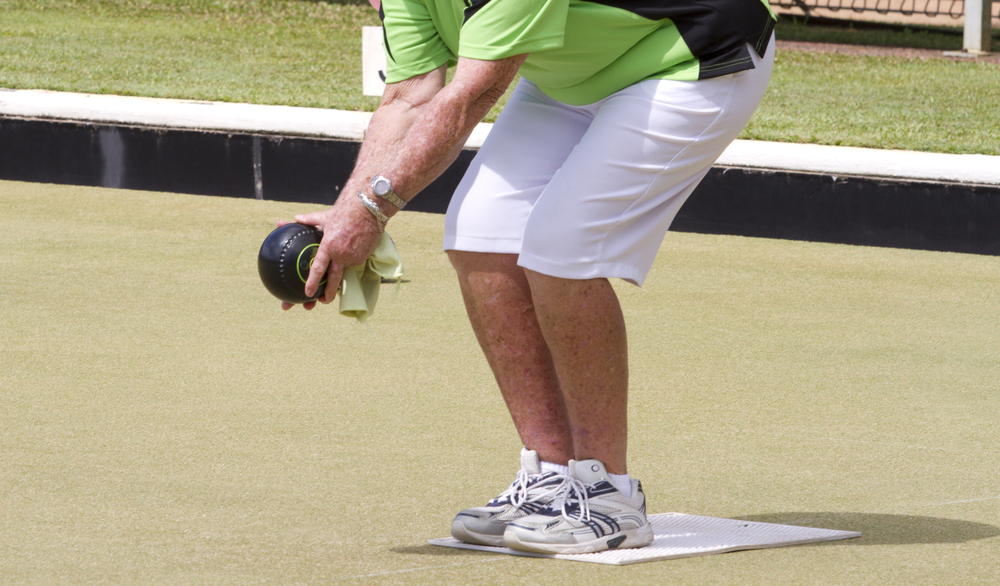
The world of bowling is way broader than you might think, filled with variations that add a unique spin to the classic ten-pin game. One such variation is Lawn Bowling, and it's sure to become one of your favorite past times. If you want to know all there is to know about the sport, this is the article for you.
In it, we’ll cover the basics of lawn bowling, including its history, the game rules, how to sharpen your skills, and more.
Contents
- 1 What is Lawn Bowling?
- 2 The History of Lawn Bowling
- 3 Important Lawn Bowling Terms
- 4 How to Play Lawn Bowling
- 5 How Many Rounds Are in Lawn Bowling?
- 6 How Does Scoring Work in Lawn Bowling?
- 7 Is Lawn Bowling the Same as Bocce?
- 8 How Do You Win at Lawn Bowls?
- 9 Is Lawn Bowling the Same as Regular Bowling?
- 10 Is Lawn Bowling a Good Workout?
- 11 Frequently Asked Questions
What is Lawn Bowling?
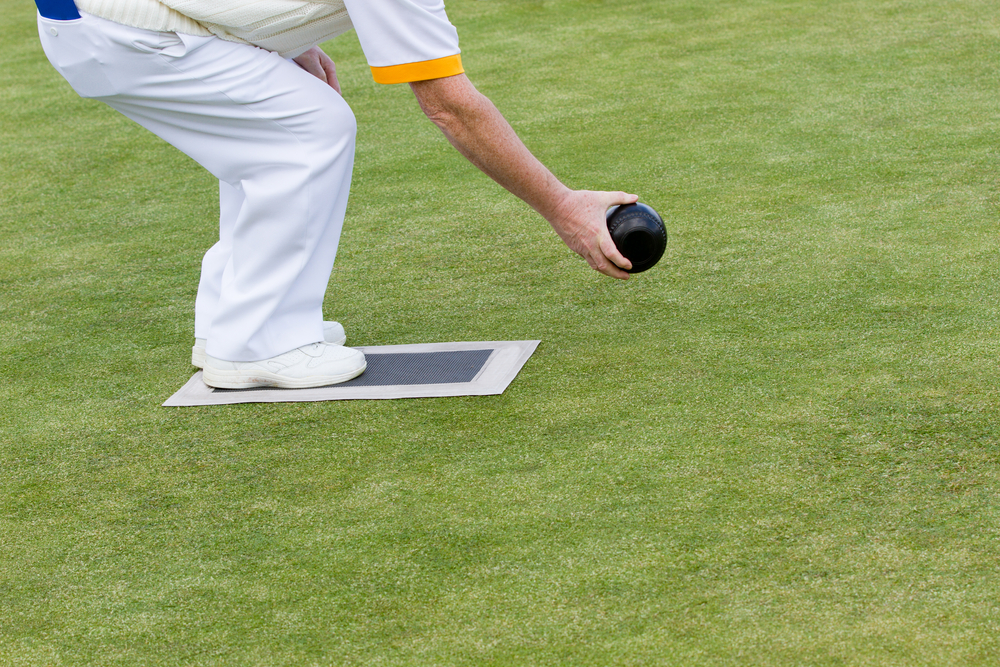
Lawn Bowling is a bowling game played outdoors on a flat, green lawn. The sport involves rolling biased (not symmetrical) balls (or bowls) toward a target (also called a jack). The objective of the game is to get your bowls as close to the jack as possible.
It’s a game that’s perfect for virtually all ages and invites you to enjoy the great outdoors. World Bowls is the governing body of the sport as a whole. Then, there’s Bowls USA, the 7 Divisions of Bowls, and local Lawn Bowl clubs.
There are other governing bodies for the sport as well– the Victorian Bowling Association in Australia, for example.
Key Takeaways
- Lawn Bowling Overview: An outdoor game played on flat, green lawns where players roll biased balls toward a target called a jack. Governed by World Bowls, with national and local clubs, it’s suitable for all ages and encourages outdoor activity.
- Historical Roots: Originates from Egypt over 5,000 years ago, evolving through civilizations and gaining popularity in Europe by the 12th century. It faced bans and exclusivity but remained widely loved, now predominantly an English sport with a presence in the United States.
- Essential Terms and Gameplay: Key terms include bias, jack, end, and bowl delivery. A game consists of rolling bowls to get closest to the jack, played over 18 to 21 ends with points awarded based on proximity to the jack.
- Differences between Bocce and Regular Bowling: Unlike bocce, lawn bowling is played on a flat green and scores for the closest bowl to the jack. It differs from regular (ten-pin) bowling in equipment, playing area, and scoring, focusing on precision over pin knockdown.
- Benefits and Winning Strategies: Offers a low-impact workout improving flexibility, coordination, and social interaction. Winning involves consistent delivery, mastering weight control, understanding the green, and employing effective game strategies.
The History of Lawn Bowling
Lawn Bowling has a long, rich Egyptian history. The sport (mixed with billiards, bowling, and lawn bowling) has been around for 5000+ years, as founded by Egyptologists Professor Edda Bresciani and his team. In ancient times, they used stone balls (natural rocks) instead of biased balls (introduced with the English version) and sticks as jacks. It also wasn’t played on grass - dirt was the playing field.
As the Egyptian version became well known with the Roman Empire, Italy (Bocce Ball), France (Petanque), and England picked up Lawn Bowling around the 12th century. Over time, the sport’s growing popularity caught the attention of the nobility. King Edward IV banned the sport in the 1400s, thinking that it took the people’s focus off of war.
He declared that it shouldn’t be played by commoners and that those who violated the law would pay a fine or even face jail time. The law did not apply to the rich or noble because they were able to obtain a license to play the game as they pleased. This ban was eventually lifted, and the game remained widely loved.
Other groups of people have enjoyed the sport throughout history, including the Saxons, Italians, and the French. It was brought to America in the 1600s but didn’t stick around much longer than the 1700s after the revolution. Today, the sport is very much an English thing, with bowling greens (areas where you play lawn bowling) found in many towns.
That’s not to say that you can’t play Lawn Bowls in the States (United States), though the community is just much, much smaller.
Important Lawn Bowling Terms
To truly understand the sport of Lawn Bowling, you need to have a firm grasp of the many terms you may hear during gameplay. Here are some important terms you should familiarize yourself with:
- Back bowl - A ball that stops after it’s gone beyond the jack.
- Backhand - When a player throws the bowl so that it curves from left to right.
- Bank - The wall just past the ditch that goes around the lawn bowling play area's perimeter (green).
- Bias - Bias is the arc trajectory that the bowl follows because of its asymmetrical (uneven) shape.
- Block or stopper - The act of throwing a bowl with the goal of blocking an opponent from making a strategic move.
- Bowls - The ball you use for Lawn Bowling. A set of bowls usually comprises 4 bowls of the same size and shape.
- Back bowl - A ball that stops after it’s gone beyond the jack.
- Center line - An imaginary line going down the middle of the rink.
- Counter - Bowls that affect the score at the completion of an end.
- Delivery - The point in time when the bowl is released from the hand.
- Ditch - A depression around the perimeter of the green. The ditch acts as the boundary that the bowls mustn’t go beyond.
- End - A single-play sequence where all of the players have delivered their bowls, and the final bowl has come to rest.
- Forehand - When a player throws the bowl so that it curves from right to left.
- Green - A grassy, low-cut surface you play lawn bowling on.
- Jack- The target ball in the game of lawn bowling. This smaller ball is typically white or yellow. Each bowler's objective is to get as close to the Jack or Kitty as possible.
- Lawn Bowl Set- a set of bowls (balls) are the actual biased bowls used to play Lawn bowls. Typically, a set includes 2 bowls per bowler.
- Measuring - The act of finding out which bowl is closest to the jack.
- Measure - The tool people use to find out which bowl is closest to the jack.
- Stance - The position a player should take on the mat before delivering the bowl.
- Toucher - When a bowl touches the jack before it comes to a stop.
- Umpire - The person who enforces the rules of the game.
- Weight - The strength used to deliver the bowl. It also refers to the speed at which the bowl is going.
- Wick - When a bowl hits one or more bowls before it finally comes to a stop.
- Wouldn’t crack an egg- What someone says when a bowl is delivered without sufficient pace to crack an egg.
*This is not an exhaustive list of Lawn Bowling terms, but it is some of the most important ones beginners should know before going out on the green.
| Term | Definition |
|---|---|
| Bias | The asymmetrical shape of the bowl that causes it to follow a curved path towards the jack. |
| Jack (or Kitty) | The target ball in Lawn Bowling, which bowls are aimed to get close to. |
| End | A single sequence of play where all players have delivered their bowls, marking a scoring opportunity. |
| Rink | The designated playing area for Lawn Bowling, bounded by the rink boundary. |
| Green | The flat, grassy area where Lawn Bowling is played, often outdoors. |
| Delivery | The action of rolling the bowl towards the jack. |
| Umpire | The official who enforces the rules of the game. |
How to Play Lawn Bowling
With the Lawn Bowling terms and history out of the way, it’s time to get into game specifics. Keep reading to learn the basic rules from beginning to end.
- Set up the Playing Area. You’ll need access to a large, grassy area for lawn bowling. Ideally, it will be in the shape of a rectangle and recently mowed to allow the bowls to roll without much resistance. Everyone will also need a set of bowls to roll during play. And, of course, you’ll need a jack (a small white ball) and a mat (for the players to deliver their bowls).
- Split Into Teams and Decide on a Scoring System. You can go for team bowling or one-on-one. Each team is usually made up of two, three, or four bowlers. If there are just two players, you’ll play singles against each other. Right now is a good time to decide how to determine who wins. In formal games, you play 18 to 21 rounds, but you may also decide that you want to set a specific point goal (first to seven points, for example).
- Flip a Coin. You’ll flip a coin to see which team or bowler will go first. The winner of the coin toss can decide whether they want to place the mat and deliver the jack. If not, they can allow the opposing team to do so.
- Set the Mat. The first bowler on the first team (also called the lead) will place the mat on the ground for play. It’s important to know that the mat should be placed on the center line of the playing area. The front of it should be at least 25 meters from the front ditch and up to 2 meters from the back ditch.
- Roll the Jack. The first player on the first team will roll the jack. Per official game rules, you must roll the jack 25 or more meters from the mat. It also shouldn’t roll into the ditch; if it does, you’ll have to throw it again. Wherever the jack comes to a stop is now the target.
- Deliver the First Bowls. Every player will throw a specific number of bowls depending on how many people are on the team. Players will roll four bowls in singles and doubles matches, three bowls in a triples match, and two bowls in a fours match. The bowler will roll all their bowls with the goal of trying to get closer to the jack than their opposing team or opponent. Once the first person on a team delivers all their bowls, the teams bowl alternately. After all the players have delivered a bowl, that’s the completion of the round (also called an end).
- Continue Playing. The teams will alternate throwing their bowls until they’ve reached 18 to 21 rounds or the winning score you set in the beginning.
How Many Rounds Are in Lawn Bowling?
In Lawn Bowling, a round is often referred to as an "end." The number of ends in a game can vary depending on the competition rules or agreement between the players. However, typically, Lawn Bowl is played over 18 or 21 ends in formal competitions.
In more informal or social games, players might agree to play for a certain amount of time or until one player or team reaches a predetermined score.
How Does Scoring Work in Lawn Bowling?
As mentioned previously, scoring in lawn bowling is based on the proximity of the bowls to the small white ball, known as the "jack". But there’s a little bit more to it. Here's how scoring in the sport works:
- End of Play: Once all bowls have been played for an end, the distance of each bowl from the jack is measured.
- Determining Points: The team or player with the bowl that measures closest to the jack is rewarded with a point. This team or player also scores an additional point for every bowl that is closer to the jack than the opponent's nearest bowl.
- Scoring Multiple Points: Unlike some other bowl-related sports, in lawn bowling, it's possible for a player or team to score multiple points in a single end. For example, if your team has the three closest bowls to the jack, your team would score three points for that end.
- Winning the Game: The game continues over a predetermined number of ends, often 18 or 21 in formal games. The player or team with the highest score at the end of the game is declared the winner.
- Tiebreaker: If there's a tie, an additional end may be played to determine the winner.
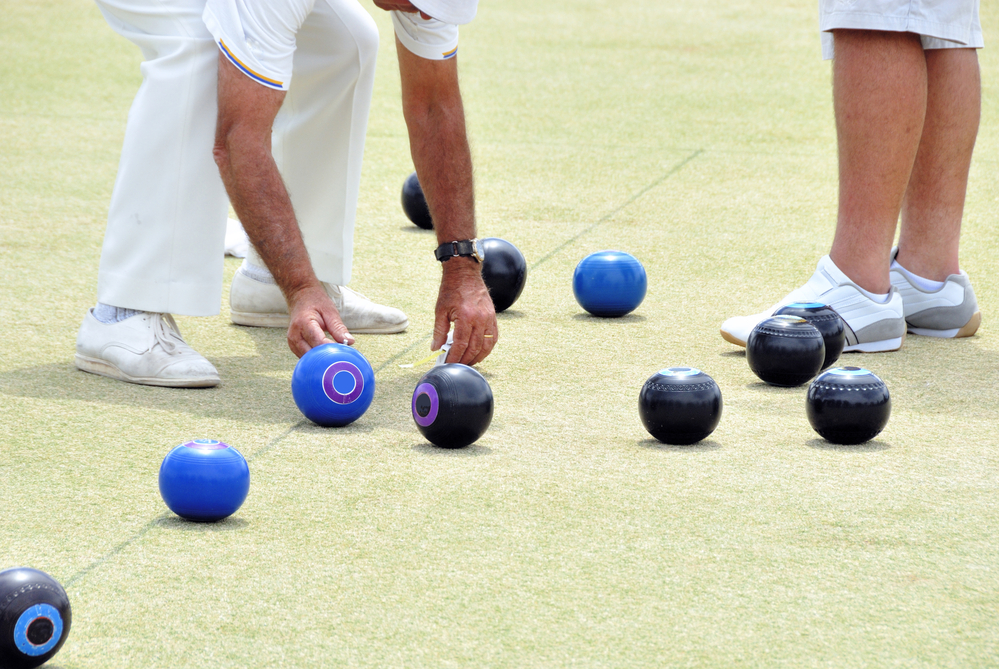
Is Lawn Bowling the Same as Bocce?
Bocce and Lawn Bowling have some similarities, but their differences are impossible to ignore.
Lawn bowling is typically played on a large, rectangular, flat green (either natural grass or artificial turf). The game’s aim is to get your ball close to the jack, which can vary in distance with each end. Scoring is exclusive, with the team or player whose bowl is closest to the jack getting a point.
By comparison, Bocce Ball offers more surface flexibility- it can be played on grass, sand, or a specialized bocce court of decomposed granite and oyster shell. The game uses a smaller ball that travels straight and targets the pallino thrown within the court.
Bocce Ball scoring allows both teams to score in a single frame. It's typically played in teams of one, two, or four. These nuances provide unique experiences in both sports, offering different strategies and techniques that make each game enjoyable in its own way.
Learn more about the differences between lawn bowling and bocce ball in this article.
| Components | Lawn Bowling | Bocce | Regular Bowling |
|---|---|---|---|
| Playing Surface | Outdoor flat green, grass or artificial | Grass, sand, or specialized court | Indoor wooden or synthetic lane |
| Objective | Closest to the jack | Closest to the pallino | Knock down pins |
| Scoring | Points for each bowl closer than opponent's | Points for both teams per frame | Points per knocked-down pin, with strikes/spares |
| Equipment | Biased balls, jack | Straight balls, pallino | Round balls, pins |
| Game Length | 18 to 21 ends | Varies | 10 frames |
How Do You Win at Lawn Bowls?
Getting the rules of the game down is essential in the beginning. But at some point, you may get serious about the sport and want to start winning those games. Here are some tips that can help you improve your game and increase your chances of winning:
- Consistent Delivery: One of the keys to success in lawn bowling is consistent delivery. Find a comfortable, repeatable delivery style and stick to it. The more consistent your delivery, the more accurately you'll be able to predict where your bowl will end up.
- Practice Your Aim: Your aim is crucial in lawn bowling, and this only improves with practice. Spend time honing your skills and understanding how the bias of your bowl affects its path.
- Master Weight Control: Understanding and controlling the weight (the force behind your throw) is another critical aspect. You need to judge how much power is needed to get your bowl to stop near the jack. Practice different weights to get a feel for it.
- Understand the Green: Each green is different and can change throughout the day. Factors such as grass length, moisture, and even wind direction can impact the bowl's journey. Take time to study the green and any other conditions that can affect your bowl’s trajectory, and adjust your play accordingly.
- Use Effective Strategies: Sometimes, it's beneficial to play defensively and block your opponent. Other times, you might want to move the jack to a new position. As you gain experience, you'll develop strategies that can disrupt your opponent's game and enhance your scoring opportunities.
- Mental Strength: Patience and focus are vital in lawn bowling. Even if things aren’t looking good, stay calm, keep your focus, and play each end to the best of your ability. A defeatist mindset will reflect badly on your game.
- Physical Fitness: Even though lawn bowling is not as physically demanding as some other sports, staying fit can improve your lawn bowling game. Good core strength can help with balance and delivery, while stamina can keep you focused and consistent, especially in longer matches.
- Join a Club or Group: Joining a lawn bowls club or group can be beneficial. You'll get to practice regularly, learn from more experienced players, and get used to playing in different conditions.
Remember, like any sport, honing your skills at Lawn Bowls takes time and practice, so be patient with yourself if you don't see immediate success. With persistence and dedication, your skills will improve over time. You might even find yourself competing in the World Championships one day!
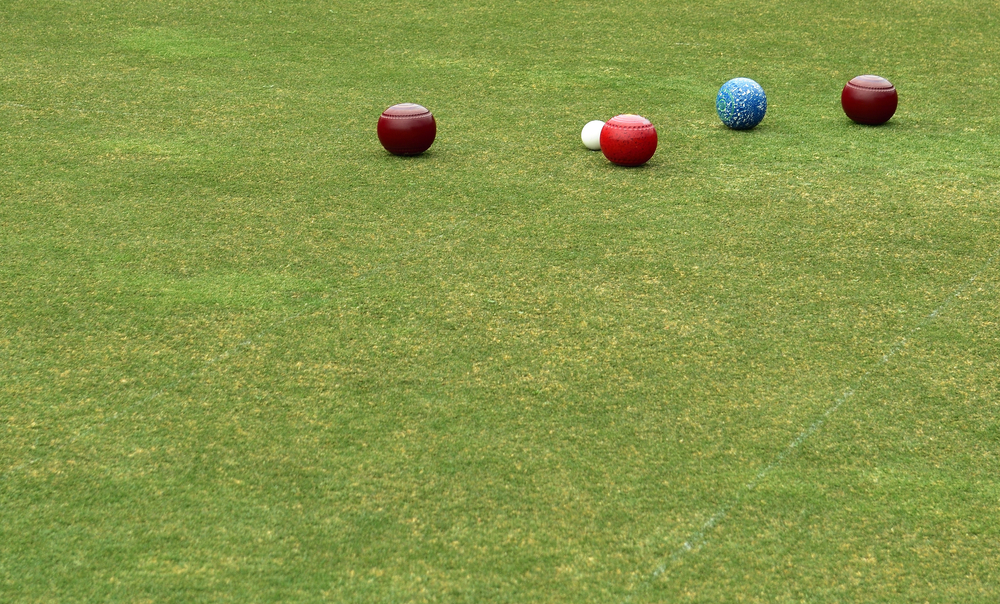
Is Lawn Bowling the Same as Regular Bowling?
Lawn Bowling may seem similar to regular Ten Pin Bowling (with pins) in some ways, but these two sports are more different than you might realize. We’ll get into the main differences in this section:
The Difference in Playing Areas for Lawn and Regular Bowling
First, Lawn Bowling is usually played outside on a green field. That’s not the case with regular bowling. Regular bowling is played indoors on a wooden or synthetic wood lane oiled to precise specifications.
The Equipment Used For Lawn and Regular Bowling
In Lawn Bowling, you use balls that aren’t perfectly round. They have an asymmetrical (uneven) design so that they curve after they’re thrown. There’s also a white ball that’s used as the target (also called the jack).
In contrast, regular bowling is done with perfectly round balls that may or may not curve or hook, depending on their design. There’s also a set of pins set at the end of the lane - they’re the target you'll try to hit.
What is The Point of Lawn and Regular Bowling
The point of Lawn Bowling is to get your ball closer to the target (jack) than your opponents. In regular bowling, the objective is to knock down as many pins as possible during each roll.
The Scoring Difference Between Lawn and Regular Bowling
Scoring in Lawn Bowling is dependent on how close you roll your bowl to the target in relation to your opponent. The team or individual whose bowl is closest to the jack scores one point and gains additional points for each of their bowls closer to the jack than the opponent's nearest bowl.
Scoring is more complex in regular bowling in comparison; each downed pin is worth one point, but additional points are awarded for strikes and spares, and these are carried over into subsequent frames. You’ll try for spares and strikes, as they get you the most points.
The Difference in Game Length for Lawn and Regular Bowling
Lawn Bowling games usually take longer than regular bowling games, often lasting two to three hours, with the game played over a set number of 'ends'. In contrast, a game of regular bowling consists of 10 frames and could be as short as 20 minutes, depending on the number of players.
In addition to the above, the United States Bowling Congress (USBC) is the governing body of regular bowling – not World Bowls or Bowls USA.
Is Lawn Bowling a Good Workout?
Lawn bowling may not seem like a physically intense sport, but it does provide a variety of health benefits that make it a good, low-impact workout. The gentle movements required for delivering the bowl improve flexibility and coordination, while the walking involved boosts cardiovascular health. It can also help tone arms, shoulders, chest, and lower body muscles, enhancing overall strength and flexibility.
The sport also demands balance, precision, and control, thereby improving these aspects over time. Lawn Bowling also offers significant mental health benefits; the focus and concentration required can aid in stress reduction, while the social interaction associated with team play can boost mood and well-being.
Playing outdoors offers added advantages of fresh air and potential vitamin D from sun exposure. Lawn Bowling, while not as vigorous as some workouts, is a valuable addition to an active lifestyle.
Frequently Asked Questions
What is another name for lawn bowling?

Lawn bowling is also referred to as Bowls.
There are many other variations of the names, including varied equipment and rules. This includes Bocce, Petanque, and Boules.
What is regular bowling called?
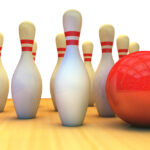
Ten pin bowling
Regular bowling is Tenpin bowling, a target game played indoors on bowling lanes. The objective is to roll a bowling ball down the lane and hit the targets or bowling pins.
Are there pins in lawn bowling?

No
There are no pins in lawn bowling. The target in lawn bowling is the smaller ball called 'a jack'. The jack is a nonbiased ball that will roll straight. Bowling pins are included in these games: tenpin, ninepin, fivepin, Candlepin, and Duckpin
What does jack high mean in Bowls?
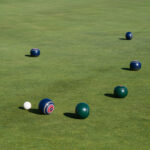
When the bowl and the jack are aligned.
More specifically, per World of Bowls, the bowl's nearest part is laterally aligned with the jack.
Related Articles
My Final Words
Lawn Bowling, generally played on meticulously maintained flat green bowls, is a compelling blend of precision and strategy, demanding both individual skill and team coordination. The balls, crafted from a hard plastic composite material, are designed to travel a curved path towards the jack, challenging the same bowler to adapt to varying outdoor surfaces and conditions. In bowling parlance, mastering this curve is essential, as is the strategic role of the team captain in directing plays and positioning within the rink boundary.
While the game thrives in outdoor settings, international competition has also brought it to indoor venues, expanding its accessibility and popularity. Whether on a global stage or a local green, the essence of Lawn Bowling lies in its ability to blend physical precision with tactical depth, offering a unique experience that extends well beyond the straight line from bowl to jack.
Kira Byrd, a Certified Fraud Examiner, holds a B.S. in Accounting from the University of Alabama at Birmingham. With a passion for bowling from her childhood, Kira has poured her expertise and personal experiences into creating and nurturing Bowling For Beginners. Kira's mission is to meet new bowlers where they are and guide them toward consistently achieving higher scores. With a focus on skill development and strategic techniques, she empowers readers to take control of their game and unlock their true potential.
Bowling For Beginners embodies strict editorial integrity, ensuring reliable and unbiased information. Kira's commitment to delivering valuable insights and practical strategies is reflected in every article. Here's an explanation of our editorial policy and how we get money.


